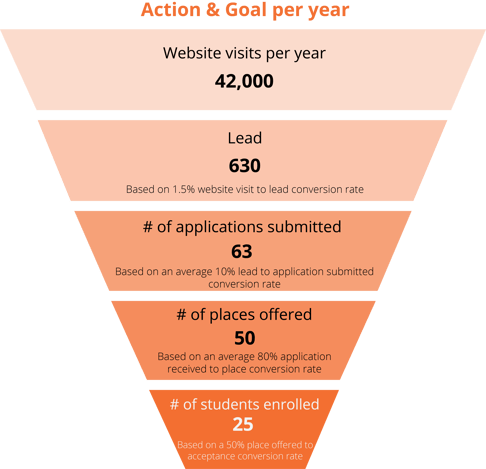Having goals in place for your Chinese digital presence is important to keep you on track with your ongoing digital marketing execution. They should be based on your current digital marketing performance, as well as how many students you’re trying to attract through your direct digital channels over the next three years. Knowing what your Chinese international student recruitment goal is, will help you work backwards to understand how much traffic and leads you will need to drive to achieve this goal. Below, we have provided you with an example of what this could look like and provides some insights into the factors that you may want to consider in your own conversion rates.
Based on your starting position and your student acquisition goals, you can build out your own funnel and estimate how much budget you need to achieve your organisation’s goals – and given your current budget how long it’s going to take to reach your goal.
Sample student acquisition funnel and conversion rate benchmarks
Chinese website visits per year
Goal: 42,000 visits
Lead (fills in an enquiry form or downloads content)
Goal: 630 (Based on a 1.5% website visit to lead conversion rate)
This is an average conversion rate and results may differ greatly by channel. For instance, conversion from organic search tends to be much higher than from paid media.
Another reason to make SEO a priority for your Chinese website!
Number of applications submitted
Goal: 63 (Based on an average 10% lead to application submitted conversion rate)
The conversion rate will depend a lot on the quality of the lead information collected which tends to depend on the students' readiness to apply.
For instance, a student at the consideration stage of their application journey is more likely to submit a lot of detail than someone who is just at the early stages of gathering information. In this case, the conversion rate would be higher but you will also receive less leads at this level of qualification.
This funnel also doesn’t factor in leads that may come in through agents or other channels, so if you have other activity that is fueling your Chinese student acquisition strategy, this needs to be factored into your overall goal setting too.
Number of places offered
Goal: 50 (Based on an 80% application received to place offered conversion rate)
This conversion rate includes conditional and unconditional offers. For instance, many Chinese applicants may meet the academic requirements, but are offered a conditional place based on meeting their English requirements. The split between conditional and unconditional offers varies greatly from institution to institution.
Number of students enrolled
Goal: 25 (Based on a 50% place offered to acceptance conversion rate.)
In our experience, the place offered to acceptance conversion rate is higher for China than for other markets. This is due to the fact that Chinese students tend to approach the process very seriously and apply only to schools they actually want to attend.
Note: We appreciate that very often budgets get allocated without taking these things into account. Going through this exercise is nonetheless worthwhile as it will help you make the case for more appropriate budget allocations going forward.
Setting goals ensures your digital marketing activities to stay on track and understand where you need to improve and where you can continue with the techniques already in place. There are many aspects put towards creating a successful digital marketing campaign. Download our China digital strategy guide for education marketers.












